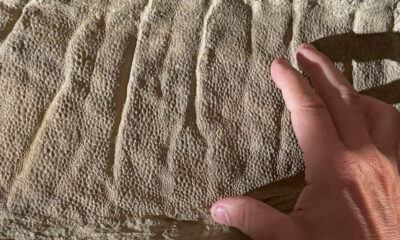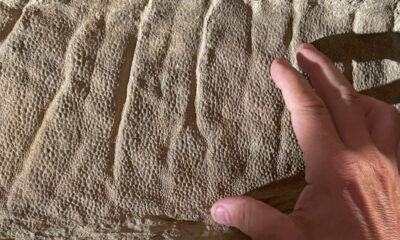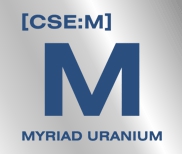Science
Wyoming Researchers Uncover New Insights on Duck-Billed Dinosaurs

A team of paleontologists led by Paul C. Sereno, a professor at the University of Chicago, has made significant discoveries regarding the dinosaur species Edmontosaurus annectens. The research, conducted in east-central Wyoming, reveals new details about this large herbivorous dinosaur that roamed the Earth toward the end of the Cretaceous period.
The original skeleton of Edmontosaurus was unearthed in 1908 by fossil collector C.H. Sternberg. This specimen, known as the “AMNH mummy,” is now housed at the American Museum of Natural History in New York. It provided early insights into the appearance of this duck-billed dinosaur, including the imprint of scaly skin found in the surrounding sediment. However, recent findings have offered a far more detailed image of Edmontosaurus.
Returning to the site where Sternberg made his discovery, Sereno’s team uncovered two additional Edmontosaurus mummies. These new specimens revealed intricate details of the dinosaur’s external anatomy, including the size of its scales and the arrangement of spikes on its tail, all preserved in a remarkably thin layer of clay.
Revising Historical Depictions
The visualization of Edmontosaurus has evolved significantly since its initial depiction in 1909 by paleoartist Charles R. Knight. Knight’s interpretation was based on the first specimen but included inaccuracies, such as extending a crest along the entire body. Subsequent interpretations, including one by renowned paleontologist Jack Horner in 1984, also contained errors that misrepresented the dinosaur’s features.
Sereno’s team aimed to clarify these discrepancies by retracing Sternberg’s steps using his often ambiguous notes. They interviewed local farmers and managed to locate the “mummy zone,” a fertile area for Cretaceous fossils covering less than 10 kilometers in diameter. Notably, the geological context of the Lance Formation, where these fossils were found, plays a crucial role in understanding their preservation.
Geological Context and Preservation Techniques
The Lance Formation, which extends across several states, including North Dakota and Montana, features a striking geological consistency. In the mummy zone, the formation’s thickness increases dramatically to over a thousand meters, suggesting a high sedimentation rate likely caused by frequent flooding from a nearby river. This flooding buried dinosaurs under layers of mud, leading to what is referred to as “clay templating.”
This preservation technique allowed clay to adhere to the skin of the deceased animals, creating a detailed mask of their appearance. Sereno noted that while clay templating is known in deep-sea invertebrates, this was the first time it had been recognized in large dinosaurs.
The two newly discovered Edmontosaurus skeletons, covered by clay less than a millimeter thick, have provided unprecedented insight into the dinosaur’s physical characteristics. Modern imaging technologies, including CT scans and photogrammetry, have allowed the team to reconstruct the skin model, leading to significant updates in the understanding of Edmontosaurus.
Among the most surprising findings were the small size of its scales, averaging only 1 to 4 millimeters, and the presence of hooves. The dinosaur’s forelegs featured singular, central hooves that resemble those of modern horses, while its hind legs had three wedge-shaped hooves. This indicates that such adaptations existed in dinosaurs long before mammals evolved similar features.
In addition to Edmontosaurus, Sereno’s team has also discovered mummies of other species, including a well-preserved T. rex and a Triceratops. The T. rex mummy, found in a life-like pose, suggests it may have been buried alive, while the Edmontosaurus specimens were likely buried after dying.
The ongoing research highlights the physiological differences between these two species, particularly in the structure of their skin and scales. This work not only enhances the understanding of Edmontosaurus but also contributes to the broader narrative of dinosaur evolution and adaptation.
As Sereno aptly puts it, “We are in the age of discovery. There are so many things to come. It’s just the beginning.” The findings related to Edmontosaurus and other mummies are expected to be published in upcoming scientific papers, further enriching the field of paleontology.
-

 Politics1 week ago
Politics1 week agoSecwepemc First Nation Seeks Aboriginal Title Over Kamloops Area
-

 World4 months ago
World4 months agoScientists Unearth Ancient Antarctic Ice to Unlock Climate Secrets
-

 Entertainment4 months ago
Entertainment4 months agoTrump and McCormick to Announce $70 Billion Energy Investments
-

 Lifestyle4 months ago
Lifestyle4 months agoTransLink Launches Food Truck Program to Boost Revenue in Vancouver
-

 Science4 months ago
Science4 months agoFour Astronauts Return to Earth After International Space Station Mission
-

 Technology3 months ago
Technology3 months agoApple Notes Enhances Functionality with Markdown Support in macOS 26
-

 Top Stories1 month ago
Top Stories1 month agoUrgent Update: Fatal Crash on Highway 99 Claims Life of Pitt Meadows Man
-

 Sports4 months ago
Sports4 months agoSearch Underway for Missing Hunter Amid Hokkaido Bear Emergency
-

 Politics3 months ago
Politics3 months agoUkrainian Tennis Star Elina Svitolina Faces Death Threats Online
-

 Politics4 months ago
Politics4 months agoCarney Engages First Nations Leaders at Development Law Summit
-

 Technology4 months ago
Technology4 months agoFrosthaven Launches Early Access on July 31, 2025
-

 Top Stories3 weeks ago
Top Stories3 weeks agoFamily Remembers Beverley Rowbotham 25 Years After Murder





















